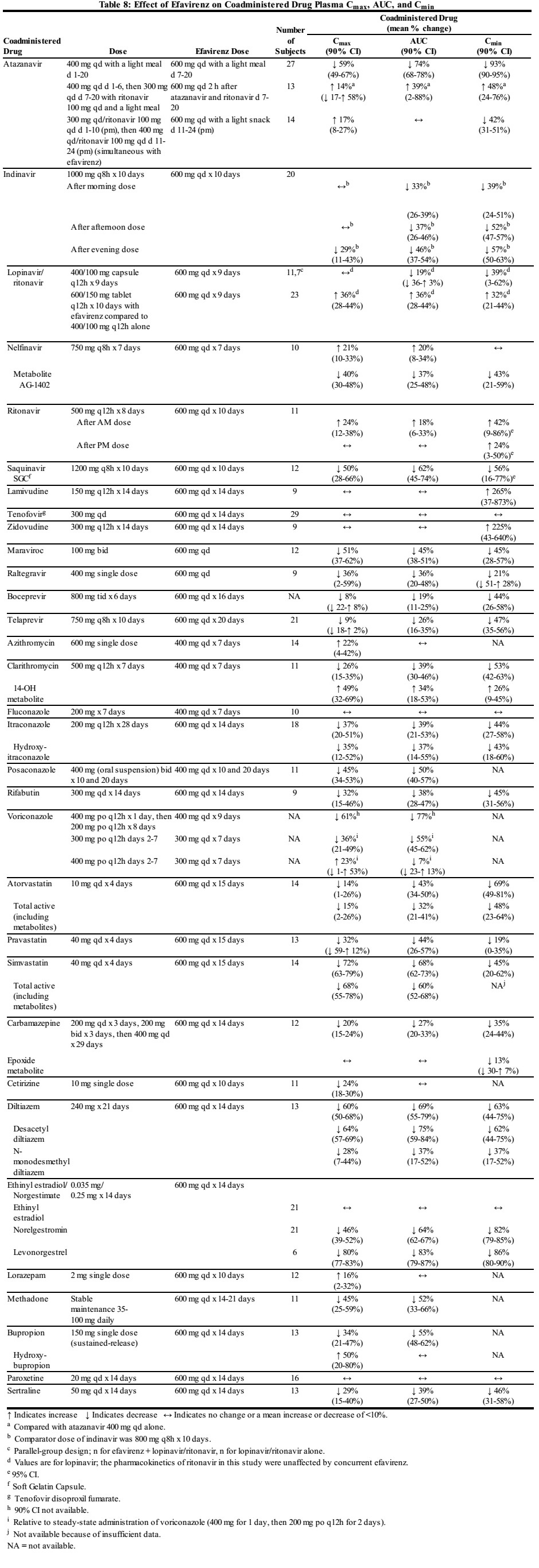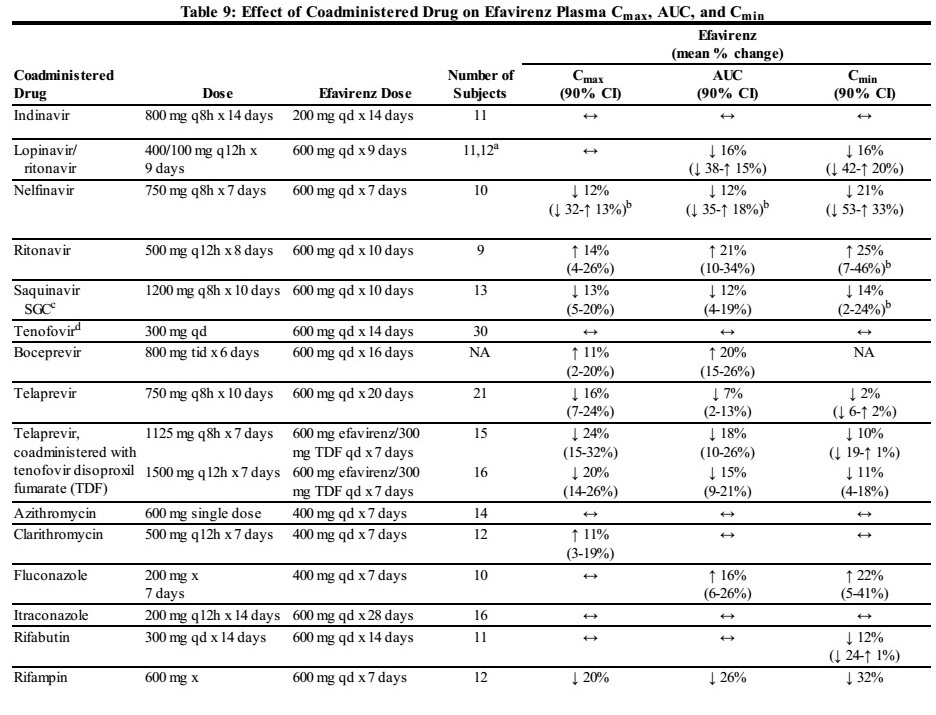Efavirenz clinical pharmacology
Editor-In-Chief: C. Michael Gibson, M.S., M.D. [1]; Associate Editor(s)-in-Chief: Ahmed Zaghw, M.D. [2]
Clinical Pharmacology
Mechanism of Action
Efavirenz is an antiviral drug.
Pharmacokinetics
Absorption
Peak efavirenz plasma concentrations of 1.6-9.1 μM were attained by 5 hours following single oral doses of 100 mg to 1600 mg administered to uninfected volunteers. Dose-related increases in Cmax and AUC were seen for doses up to 1600 mg; the increases were less than proportional suggesting diminished absorption at higher doses.
In HIV-1-infected patients at steady state, mean Cmax, mean Cmin, and mean AUC were dose proportional following 200 mg, 400 mg, and 600 mg daily doses. Time-to-peak plasma concentrations were approximately 3-5 hours and steady-state plasma concentrations were reached in 6-10 days. In 35 patients receiving SUSTIVA 600 mg once daily, steady-state Cmax was 12.9 ± 3.7 μM (mean ± SD), steady-state Cmin was 5.6 ± 3.2 μM, and AUC was 184 ± 73 μM•h.
Effect of Food on Oral Absorption
Capsules: Administration of a single 600 mg dose of efavirenz capsules with a high-fat/high-caloric meal (894 kcal, 54 g fat, 54% calories from fat) or a reduced-fat/normal-caloric meal (440 kcal, 2 g fat, 4% calories from fat) was associated with a mean increase of 22% and 17% in efavirenz AUC∞ and a mean increase of 39% and 51% in efavirenz Cmax, respectively, relative to the exposures achieved when given under fasted conditions. See Dosage and Administration (2) and Patient Counseling Information(17.3).
Tablets: Administration of a single 600 mg efavirenz tablet with a high-fat/high-caloric meal (approximately 1000 kcal, 500-600 kcal from fat) was associated with a 28% increase in mean AUC∞ of efavirenz and a 79% increase in mean Cmax of efavirenz relative to the exposures achieved under fasted conditions. See Dosage and Administration (2) and Patient Counseling Information (17.3).
Bioavailability of capsule contents mixed with food vehicles: In healthy adult subjects, the efavirenz AUC when administered as the contents of three 200 mg capsules mixed with 2 teaspoons of certain food vehicles (applesauce, grape jelly or yogurt, or infant formula) met bioequivalency criteria for the AUC of the intact capsule formulation administered under fasted conditions.
Distribution
Efavirenz is highly bound (approximately 99.5-99.75%) to human plasma proteins, predominantly albumin. In HIV-1 infected patients (n=9) who received SUSTIVA 200 to 600 mg once daily for at least one month, cerebrospinal fluid concentrations ranged from 0.26 to 1.19% (mean 0.69%) of the corresponding plasma concentration. This proportion is approximately 3-fold higher than the non-protein-bound (free) fraction of efavirenz in plasma.
Metabolism
Studies in humans and in vitro studies using human liver microsomes have demonstrated that efavirenz is principally metabolized by the cytochrome P450 system to hydroxylated metabolites with subsequent glucuronidation of these hydroxylated metabolites. These metabolites are essentially inactive against HIV-1. The in vitro studies suggest that CYP3A and CYP2B6 are the major isozymes responsible for efavirenz metabolism.
Efavirenz has been shown to induce CYP enzymes, resulting in the induction of its own metabolism. Multiple doses of 200-400 mg per day for 10 days resulted in a lower than predicted extent of accumulation (22-42% lower) and a shorter terminal half-life of 40-55 hours (single dose half-life 52-76 hours).
Elimination
Efavirenz has a terminal half-life of 52-76 hours after single doses and 40-55 hours after multiple doses. A one-month mass balance/excretion study was conducted using 400 mg per day with a 14C-labeled dose administered on Day 8. Approximately 14-34% of the radiolabel was recovered in the urine and 16-61% was recovered in the feces. Nearly all of the urinary excretion of the radiolabeled drug was in the form of metabolites. Efavirenz accounted for the majority of the total radioactivity measured in feces.
Special Populations
Pediatric
The pharmacokinetic parameters for efavirenz at steady state in pediatric patients were predicted by a population pharmacokinetic model and are summarized inTable 7 by weight ranges that correspond to the recommended doses.
 |
Gender and race
The pharmacokinetics of efavirenz in patients appear to be similar between men and women and among the racial groups studied.
Renal impairment
The pharmacokinetics of efavirenz have not been studied in patients with renal insufficiency; however, less than 1% of efavirenz is excreted unchanged in the urine, so the impact of renal impairment on efavirenz elimination should be minimal.
Hepatic impairment
A multiple-dose study showed no significant effect on efavirenz pharmacokinetics in patients with mild hepatic impairment (Child-Pugh Class A) compared with controls. There were insufficient data to determine whether moderate or severe hepatic impairment (Child-Pugh Class B or C) affects efavirenz pharmacokinetics.
Drug Interaction Studies
Efavirenz has been shown in vivo to cause hepatic enzyme induction, thus increasing the biotransformation of some drugs metabolized by CYP3A and CYP2B6. In vitrostudies have shown that efavirenz inhibited CYP isozymes 2C9, 2C19, and 3A4 with Ki values (8.5-17 μM) in the range of observed efavirenz plasma concentrations. In in vitro studies, efavirenz did not inhibit CYP2E1 and inhibited CYP2D6 and CYP1A2 (Ki values 82-160 μM) only at concentrations well above those achieved clinically. The inhibitory effect on CYP3A is expected to be similar between 200 mg, 400 mg, and 600 mg doses of efavirenz. Coadministration of efavirenz with drugs primarily metabolized by CYP2C9, CYP2C19, CYP3A, or CYP2B6 isozymes may result in altered plasma concentrations of the coadministered drug. Drugs which induce CYP3A and CYP2B6 activity would be expected to increase the clearance of efavirenz resulting in lowered plasma concentrations.
Drug interaction studies were performed with efavirenz and other drugs likely to be coadministered or drugs commonly used as probes for pharmacokinetic interaction. The effects of coadministration of efavirenz on the Cmax, AUC, and Cmin are summarized in Table 8 (effect of efavirenz on other drugs) and Table 9 (effect of other drugs on efavirenz).[1]
 |
 |
References
Adapted from the FDA Package Insert.